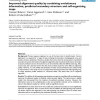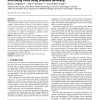820 search results - page 12 / 164 » Using Multiple Alignments to Improve Gene Prediction |
BMCBI
2006
13 years 7 months ago
2006
Background: Protein sequence alignment is one of the basic tools in bioinformatics. Correct alignments are required for a range of tasks including the derivation of phylogenetic t...
BMCBI
2008
13 years 7 months ago
2008
Background: The structure of many eukaryotic cell regulatory proteins is highly modular. They are assembled from globular domains, segments of natively disordered polypeptides and...
BIOINFORMATICS
2007
13 years 7 months ago
2007
ALMOB
2006
13 years 7 months ago
2006
Background: An important challenge in eukaryotic gene prediction is accurate identification of alternatively spliced exons. Functional transcripts can go undetected in gene expres...
BMCBI
2006
13 years 7 months ago
2006
Background: The accuracy of protein secondary structure prediction has steadily improved over the past 30 years. Now many secondary structure prediction methods routinely achieve ...


